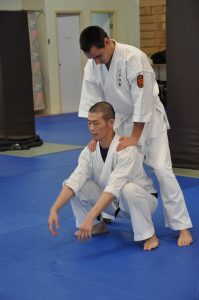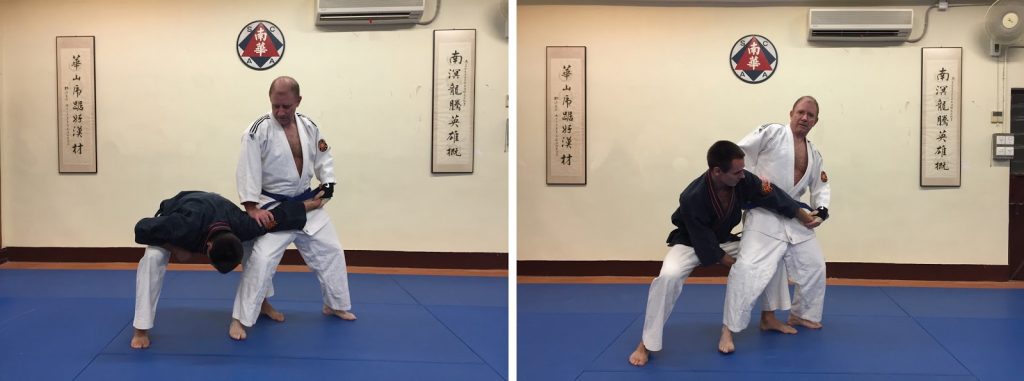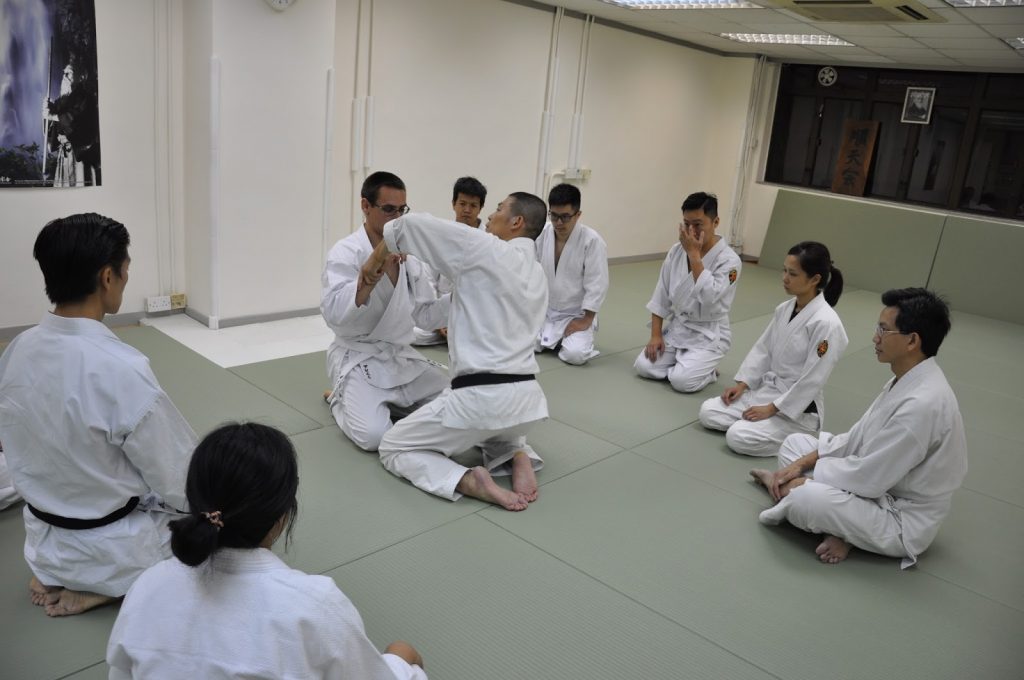This article was originally published in French in the magazine “Dragon Special Aikido” in October 2015 and was an excellent opportunity for me to share my feelings about the Aunkai approach of the Aunkai vis-a-vis other disciplines I studied, including Aikido.
Morihei Ueshiba is still recognized today as a martial phenomenon, but if we are in some way his descendants, it is certainly difficult to realize what his practice used to be. One particular element that seems to be often forgotten is the prodigious strength he had. Physically weak in his youth, Ueshiba practiced martial arts to strengthen his body to the point of reaching about 80kgs for 1m52. There are still some testimonies of his incredible strength and that of Mochizuki sensei, uchi-deshi before the war and founder of Aikido Yoseikan deeply marked me. In this testimony, he explains that the way Ueshiba was doing Aikido could only work for him and that it would be ridiculous to try to mimic it, explaining that when he grasped your wristm it was already bruised and that he could break it just by grasping it. One immediately sees that this man had unusual body abilities but one also understands that Aikido as practiced by its founder was not limited to its technical elements.
Like many practitioners, I started martial arts with an external practice, namely Nihon Tai Jitsu, a descendant of Mochizuki Minoru sensei’s Yoseikan Aikido. Nihon Tai Jitsu is a particularly rich school, containing several hundred empty hands techniques, including strikes with all the body’s natural weapons, locks, throws, chokes and a wide range of sutemi, the “trademark” of Yoseikan. After a little more than ten years of study, and a second dan in hand, I had accumulated a relatively substantial technical background, but I still felt I was missing something without being able to really pinpoint what it was. My encounter with Akuzawa sensei clearly highlighted what I was missing: the body that could apply these techniques.
Aunkai – A Reversed Approach
Aunkai is a relatively new method, created in 2002, that has chosen to concentrate solely on the formation of the body rather than on the multiplication of techniques. Although still relatively confidential, the method has found a large and passionate audience in France, a country that its founder Akuzawa Minoru visits twice a year.
Akuzawa sensei began martial arts as a teenager with Chinese arts, including Sanda, of which he won the first World Cup. Later on, he met an adept from a Koryu who taught him the basics of taijutsu and how to use the body. It is this teaching that inspired the creation of Aunkai. After about a year with him, Akuzawa sensei practiced for about two years in the Sagawa dojo, where he was again particularly interested in how to use the body and the exercises created by Sagawa sensei.
Visually speaking, Aunkai could look like a form of Qi Gong, which contrasts with the power displayed by its founder. The specificity of Aunkai lies in its approach, almost opposite to that of other Japanese arts, including Aikido. Aikidoka will practice basic techniques for several years. Ikkyo, nikkyo, sankyo, yonkyo, kote gaeshi … and these against different attacks, in omote and ura. The technical work has a central place, as it educates the body through a work on distance, directions, timing. It teaches how to feel how the force goes in and out of the body. Or at least it should. It should, because it is clear that it is easy to miss out on the basics when training on techniques, simply because the technique cannibalizes everything else.
More than once in Aikido, or in Nihon Tai Jitsu, I found myself performing a technique too fast, too strong, without respecting the most basic criteria. Just because in the heat of the action, what mattered was to apply the technique on my partner. The end justifies the means … it is probably true in the short term but it also limits the progression in the longer term.
Forging and reorganizing the body
The term tanren (錬 錬) is used in Aunkai to describe solo exercises. This word means training, forging, disciplining and the use of the radical 金 (metal) insists on this idea of forging. The Chinese etymology (鍛煉) is even more interesting because it uses the radicals of metal (金), but also of fire (火), reinforcing even more the idea of forging the body, as one would forge the blade of a sword, by working hard on removing the impurities of the metal.
When you ask Akuzawa sensei what he teaches, one of the answers that most often comes back is “to stand, to walk, to sit”. One can easily smile at the apparent simplicity of this answer. After all, have we not been doing these activities everyday since childhood? One would have decent ground to believe that they are by now perfectly mastered. And yet it is remarkable to see that a simple flick of Akuzawa sensei is often enough to blow up this strong edifice we once thought we were.
The first part of this work, therefore, consists in gaining awareness of our body, our limbs, our joints and the way in which this whole system is organized. Is my head supported by my body, as it should be, or is it slightly forward, leaning towards my smartphone or computer monitor? Is my back straight or slightly bent? Maybe my body is slightly twisting? Finally is my upper body resting naturally on my pelvis? So at the end of the day, does the structure of my body allow it to stand upright without engaging a hard struggle against gravity?
It will therefore initially be a reconnaissance mission. The solo exercises make it possible to become aware of our body, to reorganize its structure, to set up its axes and to use these axes to initiate movement. This solitary work is complemented by exercises with partner to get feedback on how the force enters and leaves the body. Finally, this reorganization of the body can bring us to applications, where body movement principles will be able to be used freely.

Partner feedback – a necessary step
As essential as the practice of tanren can be, Aunkai does not skip partner training. But partner training is also brought back to its most essential appearance. Push out is the most perfect illustration of it, both in its apparent simplicity and in its incredible depth. In the simplest version of push out, the two partners face each other, legs straight, hands at shoulder height, one partner with straight arms and the other with the arms bent arms. The exercise simply consists in pushing back the partner’s arms on one side and receive his push on the other. Couldn’t be simpler. Before I met Akuzawa sensei, I started practicing the exercises, based on the DVD of the method and I really thought I already had a vague idea of what push out was about. That was until I went to Tokyo and realized that it was simply impossible for me to push my partner’s hands back.
Using a little imagination, one quickly sees the direct links between these exercises and their applications. Ultimately there is very little difference between how to apply force in push out, ikkyo or kote gaeshi: a force that uses the whole body to break Uke’s structure without losing your own balance. From Uke’s point of view, push out will also teach how receive this force and thus learn to counter these techniques.
Nihon Tai Jitsu contains a kata focusing on kaeshi waza (counter techniques), that comes from Yoseikan Aikido: Hyori no Kata. It is an advanced kata, performed in slow motion and that simulates a fight wearing an armor in which the two partners continuously apply techniques and counters. As far as I’m concerned, it is a kata that I understood only through the practice of tanren and kunren, by understanding how the force enters the body, how to receive it and redirect it, to be able to counter it. When looking carefully at the kata, we can see how the different parts of the body need to be adjusted to allow the techniques to work and it is by doing it in slow motion that we can feel the correctness of the body alignments and posture.

Destroy and rebuild
The practice of a Bujutsu or a Budo must be the opportunity to constantly question ourselves in order to move on to higher levels. In early 2010, when I decided to learn internals with Aunkai, I tacitly agreed to restart from scratch.
Aunkai, as we already understood, does not rely on forms other than the exercises to build the body. No kata, no basic techniques, only training the body. One consequence is that applications become a matter of sensation and interpretation rather than the reproduction of a model proposed by the teacher. It was an approach that really made sense to me because nothing in Aunkai was opposed to my existing practice. On the contrary, it optimized it. So my understanding of the various tanren is strongly influenced by my Nihon Tai Jitsu / Aikido filters, while other people might see a direct link with their Karate or Wing Chun school.
The tanren consist in “kneading” the body, they allow to understand the body better, but also encourage it to move in a certain way. A way that often gives meaning to the techniques we practice on a daily basis. Through the practice of tanren, the practitioner learns to unravel the techniques he has learned to grasp their essence. He can then try to apply this new understanding to his techniques, and use this experience to come back to the tanren with new ideas, thus forming a virtuous circle.
Moving away from form to grasp the essence
However, this does not mean that the curriculum of Nihon Tai Jitsu, Aikido, or any external art does not enable to understand the deeper principles of how to use the body. At most, it indicates that in my personal case, learning a wide range of techniques made me lose sight of what was at the heart of the practice.
Unlike Daito Ryu and its hundreds of techniques, Aikido chose to focus on only a handful of them. A handful that should be sufficient to grasp all the principles, and that was very likely the idea of Morihei Ueshiba. Unfortunately, very few have a background equivalent to his and very often attention is more focused on the technical form rather than on its essence, with the risk of ending up learning an empty shell. During one of my trips to Tokyo, Akuzawa sensei told me he was going to do Kote Gaeshi on me and that I was to try to block him. He did it in slow motion, I was ready, and I naively smiled when I saw him start a Kote Gaeshi that did not respect any “good” criteria of execution. Until I suddenly collapsed, like a card castle.
It is relatively easy to focus on the external aspect of the practice and miss the rest. The great strength of Aunkai from this point of view lies in the absence of techniques and therefore in the obligation to work ONLY on the principles. Perhaps to better come back to techniques afterwards.
The Age Te example
The examples of applications are endless but I chose to Age Te (suwari waza kokyu ho) because it is both a basic exercise in Aunkai and in Aikido. Visually very close in both cases, it seems to me however that they highly differ in their approach.
In Aunkai, Age Te is reduced to its simplest version. It is above all a test of structure to return to the very essence of the movement. Whereas in Aikido the emphasis will be placed on levers or on the use of “tricks” that will be used to make the technique work, in Aunkai it will be simply about Tori lifting his hands without using force despite being strongly grabbed. This will involve realigning his spine, releasing the tension in his shoulders and dropping his elbows to take Uke’s weight inside. The notion of leverage here becomes perfectly secondary.

